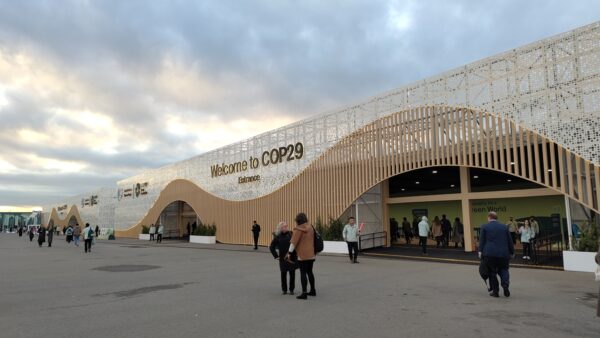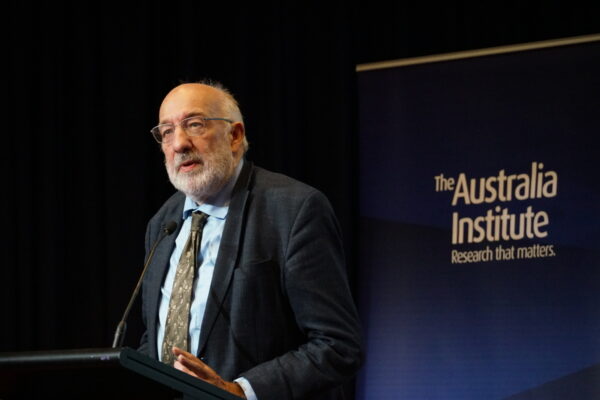Bill Hare
D.Sc. (hon. causa) (Murdoch)
CEO / Senior Scientist
Board, Executive Team, Management Team

Bill Hare is a physicist and climate scientist with 30 years’ experience in science, impacts and policy responses to climate change and stratospheric ozone depletion. He is a founder and CEO of Climate Analytics, which was established to synthesise and advance scientific knowledge on climate change and provide state-of-the-art solutions to global and national climate change policy challenges.
Bill has contributed actively to the development of the international climate regime since 1989, including the negotiation of the 1992 UN Framework Convention on Climate Change, the 1997 Kyoto Protocol, and the Paris Agreement in 2015. Throughout this time supported international and regional scientific assessment processes, including the IPCC, in different capacities to the present time.
He was a Lead Author for the Intergovernmental Panel on Climate Change (IPCC) Fourth Assessment Report, for which the IPCC was awarded the Nobel Peace Prize in 2007. He led the influential World Bank Turn Down the Heat reports series in 2013-2014, and has authored, or co-authored, many peer-reviewed articles in leading academic journals including Nature Climate Change, Nature, Climatic Change, Regional Environmental Change, and Climate Policy.
Bill has regularly advised and presented science and policy assessments to Ministers and Heads of Government from the most vulnerable countries. One of the key projects he is directing at present is the IMPACT Project, which is developing new scientific tools to help small island states (SIDS) and the least developed countries (LDCs) in West Africa respond to the impacts of climate change, as well as providing scientific support for delegations from these countries in the international climate negotiations implementing the Paris Agreement. Bill has been described as “the physicist who has become a go-to climate adviser for dozens of poor nations” and supports and advises ministers from Small Island Developing States and Least Developed Countries in the context of the UNFCCC climate negotiations.
In 2022, Bill was invited by the UN Secretary General to participate in the UN’s High-Level Expert Group on the Net-Zero Emissions Commitments of Non-State Entities, launched in March. The Group is working to develop stronger and clearer standards for net-zero emissions pledges by non-State entities to ensure accountability and deliver immediate climate action.
He is also one of the leaders of the Climate Action Tracker, recognised as one of the most credible sources of information on national and global action on climate change.
Bill is a graduate of Murdoch University in Western Australia, now Adjunct Professor, Murdoch University, School of Engineering, Perth Western Australia and a visiting scientist at the Potsdam Institute for Climate Impact Research.
Publications
- Three key near-term actions could bend the warming curve; bringing projected warming below 2°C
- Climate Action Tracker: 2025 warming projection update
- Rescuing 1.5°C: new evidence on the highest possible ambition to deliver the Paris Agreement
- Preliminary comments on “Assessing the decarbonisation role of Western Australia’s LNG exports to Asia”
- What has the Paris Agreement done for us?
- Clearing the air on methane: a global review of emissions, ambition and the policy landscape
- Hard to abate: a justification for delay?
- The global climate risks of Asia’s expansive carbon capture and storage plans
- Why stronger 2030 targets along with 1.5°C-aligned 2035 targets are essential
- Submission to the Australian Climate Change Authority
- A blueprint for climate leadership: 1.5-aligned targets for Australia
- 1.5˚C aligned climate targets for Western Australia
- Latest science on the 1.5°C limit of the Paris Agreement
- The full implications of Australia's North West Shelf decision
- Coetzee, Forner, Mace, Klönne, Hare. Addressing challenges in the land sector under the Paris Agreement. (2025)
- Allen, Frame, Friedlingstein, Gillett, Grassi, Gregory, Hare, House, Huntingford, Jenkins, Jones, Knutti, Lowe, Matthews, Meinshausen, Meinshausen, Peters, Plattner, Raper, Rogelj, Stott, Solomon, Stocker, Weaver, Zickfeld. Geological Net Zero and the need for disaggregated accounting for carbon sinks. Nature. (2024) https://doi.org/10.1038/s41586-024-08326-8
- Climate Action Tracker: 2024 warming projection update
- Petroni, Hare, Grant, Geffray, Waterton, Höhne, Jeffrey, Hecke. Decarbonising light-duty vehicle road transport. (2024)
- Riany, Welder, Grant, Kellou, Klönne, Hare. The role of northern forests in limiting warming to 1.5°C. (2024)
- Fracking the Kimberley: the Canning Basin development plans
- Dhame, S.D., Young, D.Y., Rosen, D.R., Klönne, U.K., Nauels, A.N., Zuniga, C.Z., Kellou, D.K., Hare, B.H. Solar geoengineering: a note to inform discussions on physical climate impacts, risks and governance issues. (2024)
- grant, hg. Australia's global fossil fuel carbon footprint. (2024)
- Guide to a good 2035 climate target
- Grant, N.G., Ellis, J.E., Heck, S.H., Hare, B.H. What good looks like: G7 climate policy 2024 update. (2024)
- Grant, N., Hare, B., Fekete, H., Höhne, N. COP28 initiatives will only reduce emissions if followed through. (2023)
- Grant, N., Fyson, C., Schleussner, C., Hare, B., Baxter, C.B. Unabated: the Carbon Capture and Storage 86 billion tonne carbon bomb aimed at derailing a fossil phase-out. (2023)
- Stockwell, C., Geiges, A., Hare, B., Ramalope, D., Heck, S., Missirliu, A., Fekete, H., Moisio, M., Höhne, N., Hans, F., Tumiwa, F. No change to warming as fossil fuel endgame brings focus onto false solutions. (2023)
- Hare. Submission on Australia's future gas strategy. (2023)
- Houlie, T., Hare, B. Emissions impossible: Unpacking CSIRO GISERA Beetaloo Middle Arm fossil gas emissions estimates. (2023)
- Hare, Roux. Submission on the Western Australia draft climate bill. (2023)
- Fyson, C., Grant, N., Hare, B. 2030 targets aligned to 1.5°C: evidence from the latest global pathways. (2023)
- Verstegen, P., Houlie, T., Hare, B. Perdaman urea plant to increase emissions in Western Australia and misses green fertiliser opportunity. (2023)
- Kellou, D., Nauels, A., Klönne, U., Schleussner, C-F., Hare, B. Solar radiation modification: a dangerous distraction from required emissions reductions. (2023)
- Welder, L., Grant, N., Aboumhaboub, T., Hörsch, J., Maxwell, V., Fyson, C., Hare, B. Clean power in South Korea. (2023)
- Houlie, T., Chapman, A., Wilson, R., Hare, B. Emissions as usual: implications for the Safeguard Mechanism of LNG and coal mine projects. (2023)
- Wilson, R., Hare, B., Grant, N., Houlie, T. Why offsets are not a viable alternative to cutting emissions. (2023)
- No room for new gas in South Korea
- 1.5°C is still in reach to reduce the worst climate risks – but only with immediate mitigation action and shifting finance
- Renewable energy transition in sub-Saharan Africa
- Massive gas expansion risks overtaking positive climate policies
- 1.5°C pathways for the Council of Europe
- Submission to the Australian Government's review of the Safeguard Mechanism
- 1.5°C Pathways for the EU27: accelerating climate action to deliver the Paris Agreement
- Institutional decarbonisation scenarios evaluated against the Paris Agreement 1.5°C goal
- Fossil gas: a bridge to nowhere
- Managing climate change risks to world heritage using the In Danger List: Griffith climate action beacon policy discussion paper
- G7 climate policy: what good looks like
- Australian government advertisement fact check
- Australian election 2022 political party and independent climate goals: analysis
- National 1.5°C compatible emissions pathways and consistent power sector benchmarks in Africa
- An assessment of the adequacy of the mitigation measures and targets of the respondent states in Duarte Agostinho v Portugal and 32 other states
- Woodside’s Scarborough and Pluto Project undermines the Paris Agreement
- Glasgow’s 2030 credibility gap: net zero’s lip service to climate action
- 1.5°C remains out of reach in the IEA's Announced Pledges Scenario
- Why gas is the new coal
- The Global Methane Pledge and 1.5°C
- Australia's 2030 emissions: states lead the way
- 1.5°C Pathways for Europe: Achieving the highest plausible climate ambition
- The value of climate cooperation
- Global Update: Climate target updates slow as science demands action
- Employment opportunities from a coal-to-renewables transition in South Korea
- Assessing the health benefits of a Paris-aligned coal phase-out for South Korea
- CAT Global Update: Climate Summit Momentum
- National 1.5°C Compatible Emissions Pathways and Consistent Power Sector Benchmarks: Indonesia, Viet Nam, Philippines, India and Japan
- A fact check of the Climate Council of Australia’s report “Aim High Go Fast”
- 1.5°C-consistent benchmarks for the US 2030 climate target
- 1.5°C-consistent benchmarks for enhancing Japan’s 2030 climate target
- Governing large-scale carbon dioxide removal: are we ready? - an update
- Coal phase-out and energy transition pathways for Asia and the Pacific
- EU 2030 emissions reduction target needs to be brought into line with the Paris Agreement 1.5°C limit
- Global update: Paris Agreement Turning Point
- The Climate Transparency Report 2020
- US and China climate goals: Scenarios for 2030 and mid-century
- Scaling up Climate Action in Australia
- Paris Agreement Compatible Sectoral Benchmarks
- Decarbonisation of Australia’s energy system: Integrated modeling of the transformation of electricity, transportation, and industrial sectors
- Transitioning towards a zero-carbon society: science-based emissions reduction pathways for South Korea under the Paris Agreement
- A government roadmap for addressing the climate and post COVID-19 economic crises
- Impact of Burrup Hub on Western Australia’s Paris Agreement Carbon Budget
- The impact of climate change on incomes and convergence in Africa
- Australia’s proposed ‘Kyoto carryover’ - nature, scale, implications, legal issues and environmental integrity of the Paris Agreement
- Inconsistencies when applying novel metrics for emissions accounting to the Paris agreement
- Auf dem Weg nach Paris? Implikationen des Paris-Abkommens für den Klimaschutzbeitrag des Verkehrs
- En route to Paris? Implications of the Paris Agreement for the German transport sector
- Update: the dangers of blue carbon offsets: from hot air to hot water?
- Greenhouse gas accounting metrics under the Paris Agreement
- Scaling up climate action in Turkey
- How can Paris Agreement commitments be improved now to close the gap to 1.5°C
- A 1.5°C Compatible Carbon Budget for Western Australia
- For climate's sake: coal-free by 2030
- Production Gap 2019 Report
- G20 Brown to Green Report 2019
- Climate governance in the Philippines
- Climate Governance in Australia
- A 1.5°C Compatible Carbon Budget for Queensland
- Towards optimal 1.5° and 2 °C emission pathways for individual countries: A Finland case study
- Global and regional coal phase-out requirements of the Paris Agreement: Insights from the IPCC Special Report on 1.5°C
- Pledged action leads to 2.9°C - time to boost national climate action
- Scaling up climate action in Argentina
- Evaluating the significance of Australia’s global fossil fuel carbon footprint
- Decarbonising South Asia and South East Asia
- A ten point agenda for delivering higher mitigation ambition
- Australian political party positions and the Paris Agreement: an overview
- Australia's power supply: brown and polluting
- Insights from the IPCC Special Report on 1.5°C for preparation of long-term strategies
- Australia’s vehicle fleet - dirty and falling further behind
- Australia Climate Factsheets - Industry
- Some progress since Paris, but not enough, as governments amble towards 3°C of warming
- The EU long-term strategy to reduce GHG emissions in light of the Paris Agreement and the IPCC SR1.5
- Scaling up climate action in the European Union: Key opportunities for transitioning to a zero emissions society
- Evaluating Australia's climate policy action
- Governing large-scale carbon dioxide removal: Are we ready?
- Why geoengineering is not a solution to the climate problem
- Scaling up climate action in South Africa
- How do we limit warming to 1.5°C: informing the Talanoa Dialogue question, “How do we get there?”
- Science-based coal phase-out pathway for Germany in line with the Paris Agreement 1.5°C warming limit: opportunities and benefits of an accelerated energy transition
- 1.5°C Hotspots: Climate Hazards, Vulnerabilities, and Impacts
- Integrated Assessment Models: what are they and how do they arrive at their conclusions?
- Extending Near-Term Emissions Scenarios to Assess Warming Implications of Paris Agreement NDCs’
- New Zealand’s Zero Carbon Bill – getting the Paris Agreement right
- Carbon budgets for the 1.5°C limit
- Science based coal phase-out timeline for Japan - Implications for policymakers and investors
- Paris Tango. Climate action so far in 2018: individual countries step forward, others backward, risking stranded coal assets
- Western Australia's gas gamble - implications of natural gas extraction in WA
- Ten key short-term sectoral benchmarks to limit warming to 1.5°C
- Why using 20-year Global Warming Potentials (GWPs) for emission targets are a very bad idea for climate policy
- Improvement in warming outlook as India and China move ahead, but Paris Agreement gap still looms large
- Getting it right matters – temperature goal interpretations in geoscience research
- Equitable emissions reductions under the Paris Agreement
- Turn down the heat: regional climate change impacts on development
- Foot off the gas: increased reliance on natural gas in the power sector risks an emissions lock-in
- Facilitating global transition: the role of Nationally Determined Contributions in meeting the long-term temperature goal of the Paris Agreement
- The Finkel Review and scientific consistency with the Paris Agreement
- Action by China and India slows emissions growth, President Trump’s policies likely to cause US emissions to flatten
- Faster and cleaner 2: it only takes a few countries to kick-start energy system decarbonisation
- A stress test for coal in Europe under the Paris Agreement
- The ten most important short-term steps to limit warming to 1.5°C
- Why negative CO2 emission technologies should not be classified as geoengineering
- Implications of the Paris Agreement for coal use in the power sector
- The 1.5°C temperature limit in the Paris Agreement and 2016 temperature records
- Implications of the 1.5°C limit in the Paris Agreement for climate policy and decarbonisation
- Science and policy characteristics of the Paris Agreement temperature goal
- What does the Paris Agreement mean for Finland and the European Union?
- Differential climate impacts for policy-relevant limits to global warming: the case of 1.5°C and 2°C
- Implications of oil extraction from the Great Australian Bight for Paris Agreement long-term goal
- Climate change impacts in Sub-Saharan Africa: from physical changes to their social repercussions
- 2.7°C is not enough – we can get lower
- The Coal Gap: planned coal-fired power plants inconsistent with 2˚C and threaten achievement of INDCs
- Analysis of equitable mitigationcontribution of countries
- Historical responsibility for climate change – from countries emissions to contribution to temperature increase
- Feasibility of limiting warming to 1.5 and 2°C
- 1.5°C risks and feasibility
- Five year commitments for the Paris Agreement: a fundamental issue for below 2°C and 1.5°C
- INDCs lower projected warming to 2.7°C: significant progress but still above 2°C
- How close are INDCs to 2°C and 1.5°C pathways?
- Australia set to overshoot its 2030 target by large margin
- New Zealand deploys creative accounting to allow emissions to rise
- Briefing note on the report on the Structured Expert Dialogue on the 2013-2015 Review
- Benchmark emission levels for 2025 and 2030 consistent with the below 2°C limit and the 1.5°C limit
- Switzerland INDC: first in, but room for improvement
- Are governments doing their “fair share”? New method assesses climate action
- Analysis of fair mitigation contribution for South Africa
- Africa's adaptation gap: bridging the gap - mobilising sources
- Zero emission targets as long-term global goals for climate protection
- Timetables for zero emissions and 2015 emissions reductions: state of the science for the ADP agreement
- Has the EU Commission weakened its climate proposal? Possibly
- Is it possible to return warming to below 1.5°C within this century?
- Disentangling the effects of CO2 and short-lived climate forcer mitigation
- China and US increase climate ambition: improvements needed in 2015
- Turn down the heat: confronting the new climate normal?
- The IPCC’s fifth assessment report and its implications for Nepal
- Rebuttal of “Ditch the 2°C warming goal!”
- Coal's rapid phase-out essential, not enough to stay below 2°C warming
- Australian Energy "Green Paper" foresees continuing increase in coal use: undermines 2°C goal and heads towards 4°C world
- China and the US: how does their climate action compare?
- Setting fair and adequate benchmarks for key countries
- Squaring the circle of mitigation adequacy and equity: options and perspectives
- Below 2°C or 1.5°C depends on rapid action from both Annex I and non-Annex I countries
- Loss and Damage in Africa
- Warsaw unpacked: a race to the bottom?
- Analysis of current greenhouse gas emission trends
- Japan: from frontrunner to laggard
- Australia - backtracking on promises
- Africa’s adaptation gap: climate change impacts, adaptation challenges and costs for Africa
- Adequacy and feasibility of the 1.5°C long-term global limit
- Turn down the heat: climate extremes, regional impacts and the case for resilience
- Climate shuffle: Climate Action Tracker update
- Emerging economies – potentials, pledges and fair shares of greenhouse gas reduction
- Warning of climate science - again - written in Doha sand
- 2° be or not 2° be
- Political implications of the long-term effect of surplus from the first and second Kyoto period
- Turn down the heat: why a 4°C warmer world must be avoided
- Governments still set on 3°C warming track, some progress, but many playing with numbers
- Closing the 2020 emissions gap: issues, options and strategies
- Long-term sea-level rise implied by 1.5 degree and 2 degree Celsius warming levels
- Climate Action Tracker Mexico – Assessment of Mexico's policies impacting its greenhouse gas emissions profile
- A scaling approach to probabilistic assessment of regional climate change
- After Durban: risk of delay in raising ambition lowers chances for 2°C, while heading for 3.5°C
- Negotiations heading towards high warming, high cost pathway
- Assessment of Australia‘s policies impacting its greenhouse gas emissions profile
- No move to close the gap at Bangkok climate talks
- Bridging the Emissions Gap
- Mitigation, pledges, impacts and effects on Least Developed Countries
- Periodic Review, background and analysis
- Science aspects of the 2°C and 1.5°C global goals in the Cancun Agreements
- Emission pathways consistent with a 2°C global temperature limit
- China emission paradox: Cancun emissions intensity pledge to be surpassed but emissions higher
- LULUCF guide
- Climate hotspots: key vulnerable regions, climate change and limits to warming
- Discrepancies in historical emissions point to a wider 2020 gap between 2 °C benchmarks and aggregated national mitigation pledges
- Climate change risks for African agriculture
- Analysis of the Copenhagen Accord pledges and its global climatic impacts‚ a snapshot of dissonant ambitions
- 2020 emission targets after applying updated GWPs from IPCC AR4
- Persistence of Atoll Islands under sea level rise
- Adequacy of Copenhagen mitigations pledges: the case for low carbon development strategies
- Ocean Acidification: Causes and Consequences
- Copenhagen Accord pledges are paltry
- Countries calling to limit warming to 1.5°C or 2°C above preindustrial
- Halfway to Copenhagen, no way to 2 °C
- How feasible is changing track? Scenario analysis on the implications of changing emission tracks after 2020, from an insufficient global deal on 2020 reductions, to 2°C and 1.5°C pathways
- Near-linear cost increase to reduce climate-change risk. PNAS. (2008) https://doi.org/10.1073/pnas.0802416106











